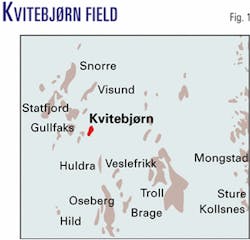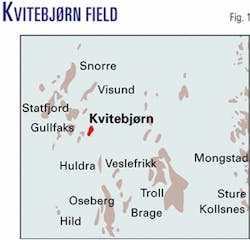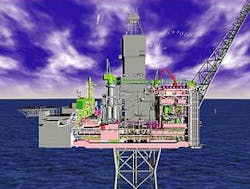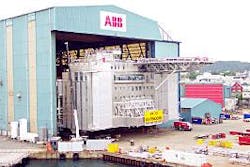Special Report: Environmentally friendly development planned for off Norway
Design of the Kvitebjørn field facility off Norway will minimize discharges to the sea and only emit a low-level of carbon dioxide, according to Statoil AS, operator of the development. Kvitebjørn is a rich gas and condensate field, scheduled to come on stream in the second half of 2004.
Norway's oil and gas industry has ambitious targets for reducing negative impacts on the environment. It expects that by 2010 there will be no harmful discharges to the sea and that greenhouse gas emissions will be as low as 52 kg/cu m of oil equivalent produced.
Statoil indicates its Kvitebjørn project will meet these targets by a wide margin.
It has designed Kvitebjørn to produce 16 kg of greenhouse gases/1 cu m of oil equivalent delivered from the platform. And it plans for only minimal discharges to sea, not enough to harm the environment.
Kvitebjørn
Kvitebjørn field is in North Sea Block 34/11, east of Gullfaks (Fig. 1). The 10 billion kroner ($1.3 billion) development includes a fully integrated fixed steel production, drilling, and quarters platform (Figs. 2 and 3), and liquid and gas trunklines to shore.
The facility's design can handle 20.7 million cu m/day (731 MMcfd) of rich gas and 10,000 cu m/day (63,000 b/d) of condensate.
Published recoverable reserves in the field are 54.2 billion cu m (1.9 tcf) of gas, 0.5 million tonnes (5 million bbl) of NGL, and 20.6 million cu m (130 million bbl) of condensate.
Statoil plans to install the platform in spring 2003, with drilling and completion work to commence immediately afterwards. Water depth in the field is 190 m, and the reservoirs lie at about 4,000 m.
Pipeline work involves laying a 150-km gas trunkline from the Kvitebjørn platform to the receiving terminal at Kollsnes, near Bergen. At Kollsnes a new NGL plant will remove propane, butane, and naphtha from the gas. The liquid will then be transported via the Vestproses pipeline to the Mongstad refinery, where it will be extracted as separate products.
The 90-km Kvitebjørn liquid pipe line will tie into the Troll Oil Pipeline II, which carries liquids to the terminal at Mongstad, also near Bergen.
Partners in the Kvitebjørn project are Statoil, 50%; Petoro AS, 30%; Norsk Hydro Produksjon AS, 15%; and TotalFinaElf Exploration Norge AS, 5%.
Facility design
Statoil says key to reducing emissions from the field are the reservoir's high pressure and high temperature.
"By using the forces in the Kvitebjørn reservoir, we can cut down on energy usage offshore and thereby achieve sizable reductions in emissions to air and sea," says Bjarne Bakken, project manager for Kvitebjørn.
Statoil developed the design in the pre-engineering stage through close cooperation with Aker Maritime ASA.
It says early planning and implementation is the best way to achieve cost effective and good environmental solutions.
The design takes advantage of the reservoir pressure of 775 bar (11,236 psi) that is sufficient to flow gas from the field through the pipeline to shore.
Also the facility uses reservoir heat, about 151° C. (304° F.), to eliminate the need to provide a separate heating medium for processing vessels on the platform.
Statoil plans to test wells through the processing vessels and will clean up wells without flaring fluids.
The facility will reinject all water, about 1,500 cu m/day (9,436 b/d), from the first and third-stage separators into the Utsira formation. Drill cuttings will also be reinjected during the drilling phase.
Statoil explains that a layer of shale above the Utsira formation at 1,000 m below the seabed acts as a seal to keep injected fluids within the formation.
Utsira is a 40% water-filled aquifer that Statoil also uses for storing reinjected CO2 in the Sleipner field.
Other energy savings and environmental friendly parts of the design include:
- Low NOx turbines that run on gas after completing the drilling of the development wells.
- Detail engineering for selecting vents and tandem dry-gas seals to minimize emissions.
- Reuse of drilling fluids to reduce costs and emissions. At the end of drilling, Statoil will ship ashore the oil and water-based drilling fluids for reuse.
- Minimal chemical discharges during drilling. As far as possible, Statoil says all used chemicals will be injected in the Utsira formation.
- Any produced sand will be cleaned on the Kvitebjørn platform.
Even with minimal discharges to sea, Statoil plans to evaluate their environmental impact by having an independent research organization measure changes and effects of these discharges around the platform.



